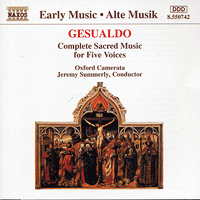There's a fine line between genius and insanity. I have erased this line.
– Oscar Levine
– Oscar Levine
The above quote could just as easily have been attributed to composer Carlo Gesualdo, Prince of Venosa, as his life story is almost as fascinating as his music. His grasp on harmony and shifting tonality is hundreds of years ahead of his time, being compared to the likes of Thelonius Monk moreso than his contemporaries. His counterpoint that rivals Bach in its elegance, and the sorrow and despair that cries out in his vocal writing is incredibly profound. Yet as fascinating as his music is, it is nearly impossible to discuss the man without discussing his personal life – driven, according to some scholars, to madness after killing his wife and her lover in cold blood. It is impossible to say if his music rose to fame because of his crimes or his crimes were a sensation because of his writing. Either way, the music stands on its own as a true, if tortured, genius of the 16th century.
Once again, my Latin is not up to snuff to follow most of these individually, so today will be more of an overview of the collection as a whole as opposed to notes on individual pieces. Gesualdo’s textures are clean and defined – almost entirely free counterpoint for five voices with longer sustained tones in most of the outer voices. The bass, as usual, defines the harmonies, and the soprano soars above. The three inner voices have most of the moving lines.
One notable exception is the one piece I’ve performed out of this collection – “O Vos Omnes.” I remember working on this with None of the Above, the accapella group I joined briefly after moving to Boston
As I’m sure I’ve noted before, I’m a bit of a stickler for form from time to time. Most of Gesualdo’s motets are thru-composed, without much return to motifs and melodies from earlier in the piece. As such, it’s harder to get a sense of form from his work. Also, there are fewer demarcations of tempo and meter breaking up pieces as was more typical of the time period. Once again, the music instead lends itself to “washing over” the listener – the counterpoint often obscures the text and the lack of form gives it a timeless sense. And yet it is intensely beautiful and more complex and awe inspiring in its intricacies than chant.
I think one of the things that fascinates me about Gesualdo as well as other composers of early counterpoint is how their tonality functions on a different level than what we find today, or in the common practice era in general (1750-1900 or thereabout.) Post tonal music moves outside of the box frequently, but the result is often the same as this “pre tonal” masterworks, written before “the box” existed so to speak. It’s like how I find my own writing stifled by instinctively following the “rules” of music theory, and how before I knew them, I still worked subconsciously within their framework, but they didn’t govern so strongly what I wrote.
Tomorrow – Mood Swings (The Swingle Singers)
Next week – Haydn: The Creation

No comments:
Post a Comment